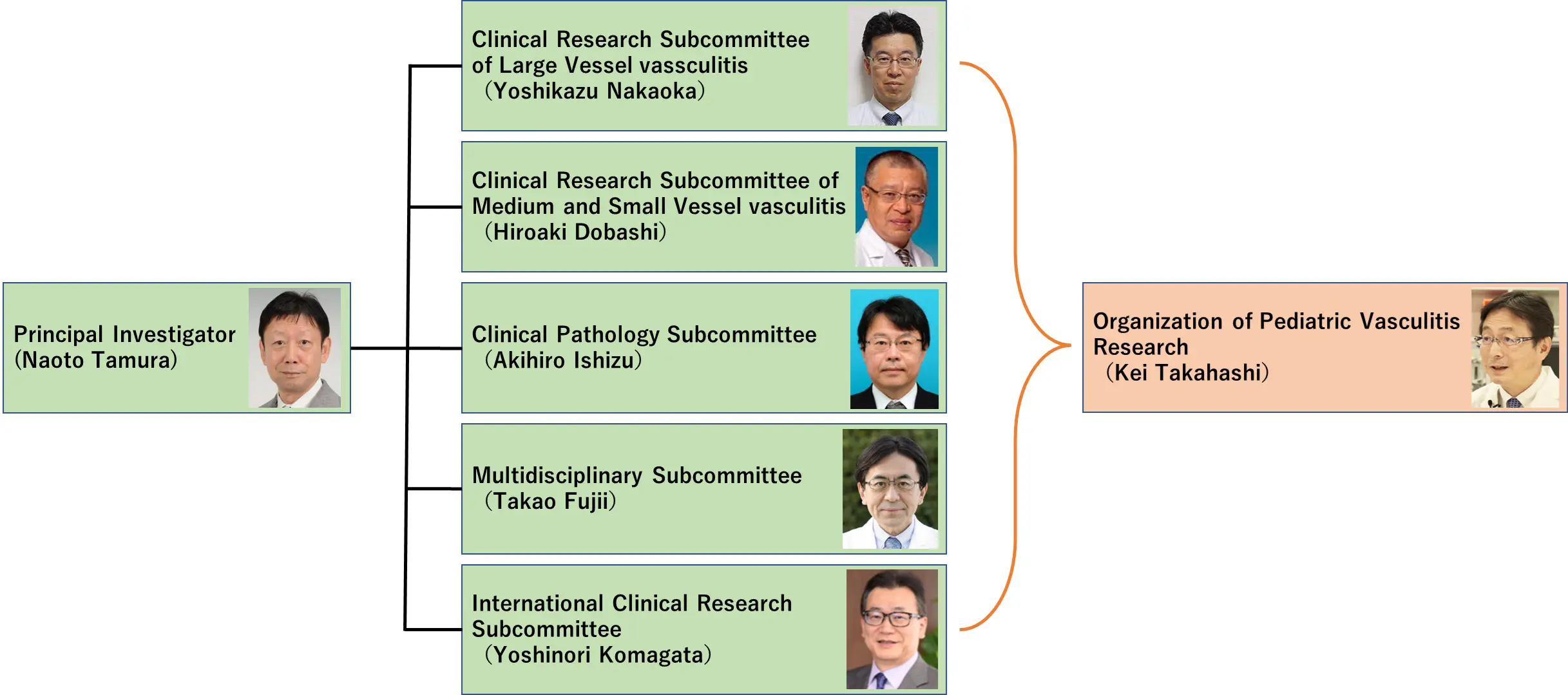Address from JPVAS leader

Welcome to the JPVAS website!
JPVAS is a central organization for vasculitis research in Japan, composed of members from multiple medical departments related to vasculitis. We are engaged in a variety of activities with the aim of contributing to the standardization and advancement of clinical and pathological diagnosis and treatment for refractory vasculitides.(Naoto Tamura, M.D., Ph.D, Department of Internal Medicine and Rheumatology, Juntendo University School of Medicine, Tokyo)
Mission of JPVAS
The Research Group for Improving Medical Standards and Patient Quality of Life for Intractable Vasculitis (Intractable Vasculitis Group) under the Intractable Disease Policy Research Project of the Ministry of Health, Labour and Welfare of Japan is working to improve medical standards and raise awareness about vasculitic diseases, with an all-Japan collaboration. The aim is to promote measures against intractable diseases and specified chronic pediatric diseases by serving as a command center for research and development promotion, thereby improving the medical standards for intractable vasculitis diseases and enhancing patients' quality of life (QOL).
History of JPVAS
Since 1972, Japan's Ministry of Health has organized research groups as a measure to investigate diseases of unknown cause and establish treatments. Research groups for rheumatoid arthritis with vasculitis, Takayasu arteritis, and Buerger's disease were established. In 1976 these research groups merged to form the Systematic Vascular Lesions Research Group. Subsequently, in 1990, the name was changed to the Intractable Vasculitis Research Group, and its activities have continued.
| year | Principal Investigator | Name of the Research Group |
|---|---|---|
| 1972-1975 | Dr. Yuichi Shiokawa | RA with vasculitis |
| 1972-1975 | Dr. Kiyoshi Inada | Takayasu arteritis |
| 1972-1975 | Dr. Koichi Ishikawa | Berger's disease |
| 1976-1978 | Dr. Yuichi Shiokawa | the Systematic Vascular Lesions Research Group |
| 1979-1984 | Dr. Yoshiro Fukuda | the Systematic Vascular Lesions Research Group |
| 1985-1989 | Dr. Yoshio Mishima | the Systematic Vascular Lesions Research Group |
| 1990-1992 | Dr. Tatsuzo Tanabe | the Intractable Vasculitis Research Group |
| 1993-1995 | Dr. Toshihiko Nagasawa | the Intractable Vasculitis Research Group |
| 1996-2001 | Dr. Hiroshi Hashimoto | the Intractable Vasculitis Research Group |
| 2002-2007 | Dr. Shoichi Ozaki | the Intractable Vasculitis Research Group |
| 2008-2013 | Dr. Hiroshi Makino | the Intractable Vasculitis Research Group |
| 2014-2016 | Dr. Yoshihiro Arimura | the Intractable Vasculitis Research Group |
| 2017-2022 | Dr. Masahiro Harigai | the Intractable Vasculitis Research Group |
| 2023- | Dr. Naoto Tamura | the Intractable Vasculitis Research Group |
Organization of JPVAS 2023-2025
6 subcommittees were established within the group, and each subcommittee chair implemented the third-year research topics.

Publication of JPVAS
Recent Topics from JPVAS
Drs. Yoshifuji and JPVAS members analyzed the impact of disease duration and sex on organ damage and quality of life using data from the Japanese Ministry of Health, Labor and Welfare (MHLW) registry for Takayasu arterites, which analyzed 2,013 cases out of a total of 2,795 cases in the 2013 fiscal year. Compared with men, women tended to have an earlier onset age, exhibiting longer disease duration. A higher proportion of women had aortic regurgitation and required nursing care. In addition, the nursing care needs were associated with brain ischemia, visual impairment/loss, and ischemic heart disease. In conclusion, they claim that the early diagnosis and effective treatment, particularly to prevent brain ischemia, visual impairment, and ischemic heart disease, may improve the quality of life of patients with Takayasu arteritis, especially women.
Yoshifuji H, Nakaoka Y, Uchida HA, Sugihara T, Watanabe Y, Funakoshi S, Isobe M, Harigai M; Japan Research Committee of the Ministry of Health, Labour, and Welfare for Intractable Vasculitis (JPVAS). Organ Damage and Quality of Life in Takayasu Arteritis - Evidence From a National Registry Analysis. Circ J. 2024 Feb 22;88(3):285-294. doi: 10.1253/circj.CJ-23-0656.

The summary of activities in 2023
- The Multidisciplinary Subcommittee conducted a questionnaire survey on the actual practice of eosinophilic granulomatosis with polyangiitis. The results of the survey on the treatment of large vessel vasculitis were published in a paper. The website of the research group was updated in collaboration with patient associations. Joint symposiums were held at the Japanese Vascular Society and the Japanese Sarcoidosis/Granulomatosis Society to share the latest knowledge on vasculitis treatment.
- The Clinical Pathology Subcommittee continued consultations on vasculitis pathology diagnosis and reported on 11 cases. They decided to develop a “Collection of Useful Staining Protocols for Pathological Diagnosis of Vasculitis” to promote the development, dissemination, and standardization of effective staining methods. The table of contents and joint authors of the protocols were decided.
- The Clinical Research Subcommittee of Large Vessel Vasculitis established a system for revising guidelines for the treatment of large vessel vasculitis and began a systematic review by inviting young researchers. They started reviewing proposed diagnostic criteria for giant cell arteritis using a retrospective cohort study. From the analysis of 311 cases, they submitted a paper on the classification ability of the 2022 ACR/EULAR classification criteria for giant cell arteritis and a paper on the treatment course of Takayasu arteritis. A paper on the clinical picture of 191 cases from a prospective study is in preparation. They published the results of individual questionnaires for Buerger's disease and Takayasu arteritis, and initiated a multicenter study on biomarkers for Takayasu arteritis complications in collaboration with the AMED research group. Analyses of a surgical case registry study, an epidemiological study using MDV data, and the investigation of tocilizumab indications in pediatric Takayasu arteritis were conducted.
- The Clinical Research Subcommittee of Medium and Small Vessel vasculitis published a paper on the classification ability of Japanese patients for the 2022 ACR/EULAR classification criteria; planned an interim analysis of the JPVAS prospective cohort (RADDER-J); examined the collection items and analysis methods for the practice, diagnosis, treatment, and prognosis of interstitial lung disease in ANCA-associated vasculitis. They prepared a revised guideline for eosinophilic granulomatosis with polyangiitis, analyzed the national epidemiological survey of polyarteritis nodosa, established a new registry of patients treated with C5a receptor inhibitors, and initiated a prospective study on safety and efficacy.
- The International Clinical Research Subcommittee organized the International Symposium on Takayasu arteritis in collaboration with the Asian and Pacific Rheumatology Association (APLAR). They participated in the VCRC Investigators Meeting and exchanged opinions on the patient pregnancy registry study VPREG, the AAV-PRO Japanese translation project, and the observational study on AAV during the COVID-19 pandemic. They supported international activities of patient associations, helped prepare for the International Vasculitis Workshop, and supported the international activities of the Patient Association.